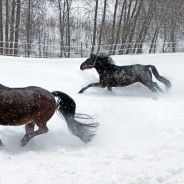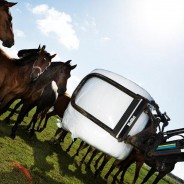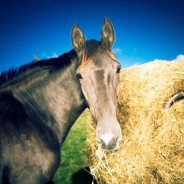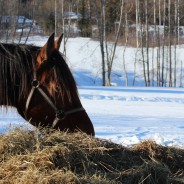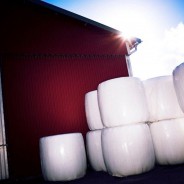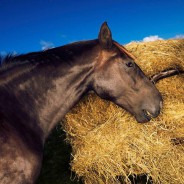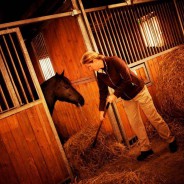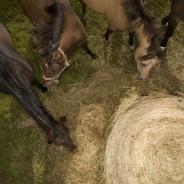The forage blog – all about forage for horses
Here AgrD Sara Muhonen blogs about feeding and forage for horses. If you have questions or suggestions on what we should discourse feel free to e-mail us via the contact page.
Give the right forage to the right horse
Forage and forage is not the same thing. How well horses can digest forage depends on the forage’s cell wall content. Cell walls are composed of cellulose fibre, hemicellulose, pectins and cell wall protein. The cell wall can be more or less lignified and the later the stage of maturity of a plant the more lignified is the cell wall and the digestibility decreases. When digestibility decreases the nutritive value of the forage also decreases. Table 1 show the results from an Icelandic digestibility study where four adjacent leys,...
read moreForage intake in two year old trotters in training
A Swedish study has investigated the forage intake in 13 two year old trotters in heavy training. The forage was a second cut grass haylage with 63% dry matter (DM), 10.8 MJ metabolizable energy/kg DM and 14% crude protein. The diet was supplemented with 150 g mineral feedstuff, 250 g pelleted lucerne and 100 g molassed beet pulp. The horses were trained 2-3 times per week, half of the exercises were done in a slightly hilly terrain (7 km) and the other half was double heats (1100-1600 m, ~10 m/s) on a racetrack. The horses spent 8 hours per...
read moreGrowth, training and health in yearlings fed a forage-only diet
A Swedish study has examined growth, exercise response and health in 16 Standardbred colts fed a forage-only diet. The forage was grass haylage with > 55% dry matter (DM), > 11.5 MJ metabolizable energy/kg DM and > 13% crude protein. The forage was complemented with 1 kg pelleted lucerne, 100 g molassed beet pulp and minerals. The study lasted from August to December 2010 and the horses were between 400 and 518 days old at the start of the trial. The horses spent most of their daytime together outside in a large paddock with free access to...
read moreWhen horses gets to choose feeding position
In many stables horses are offered forage in hay nets hanging above the ground. This implies that the horse has to eat with the head higher than in its natural feed intake position. Physiologically this leads to the horse using different muscles in the neck and back and the higher head position can impair the ability to clear particles by mucociliary cleaning. But which feeding position do horses prefer when they get to choose? In this pilot study 10 horses aged 7-17 years were used, and they were previously accustomed to eating from hay...
read moreLate harvested forage takes longer time for horses to eat
The later the maturity stage of a plant when it’s harvested the larger the fibre proportion in the forage. How well horses can digest forage depends on the forages cell wall content. The cell wall can be more or less lignified and the later the stage of maturity of a plant the more lignified are the cell walls and the digestibility decreases. When digestibility decreases the nutritive value of the forage also decreases. A study with twelve adult warm-blooded horses have also shown that the later the maturity stage (later harvest) of the...
read moreFollow up on colourful haylage bales
We got some questions on how much the different colours of the plastic film for haylage/silage bales affect the feed quality. Trioplast have performed measurements of sunlight reflectance on the different colours and here they answer how their own colours reflects sunlight. Background: Today it’s common to see wrapped bales in several different colours and the different colours support different foundations, which is great! But the colour of the plastic film can actually affect the temperature of the silage/haylage bale. The sun warms up the...
read moreHigher masseter muscle activity and chewing frequency with forage
When horses chew forage they have higher saliva production and gets to chew longer time. Low forage intake leads to different health problems like gastric ulcers, hindgut acidosis and stereotypies. When formulating the horse’s feed ration one always have to make sure it will get enough forage. In this study horses chewing frequency and masseter muscle activity were examined when feeding different feeds. The masseter muscle activity is the main determinant of salivary flow rate in the oral cavity and in this study masseter muscle activity was...
read moreFeed type affects horses’ behaviour
The horse is a large grass eating animal, an herbivore, and free-living horses graze 14-18 hours of the day. Captive animals faced with insoluble problems can develop behavioural disturbances, stereotypies. Examples of behavioural disturbances are weaving, crib-biting, box-walking and wood-chewing. Many factors influence the development of behavioural disturbances but the amount of forage the horse is fed is one of the main factors. Here this is visualized with a table: Sara Muhonen, AgrD
read moreColourful haylage bales
Today it’s common to see wrapped bales in several different colours and the different colours support different foundations, which is great! But the colour of the plastic film can actually affect the temperature of the silage/haylage bale. The sun warms up the bale and white film reflects the sunlight and thereby keeps the temperature down. Darker film on the other hand absorbs sunlight and gives a higher temperature inside the bale. Black film absorbs the most sunlight. When the temperature increases the permeability of the film also...
read moreTall fescue has lower digestibility than timothy/meadow fescue
In this Finnish study two grass leys were compared, a mixture of timothy (Phleum pratense) and meadow fescue (Festuca pratensis) and a pure tall fescue (Festuca arundinacea). Both leys were divided into three parts harvested at three different dates; 19 June, 26 June and 3 July during the summer of 2006. The crop was prewilted for 8-24 h before round-baling and they used an acid based additive to improve ensiling. Dry matter (DM) of the wrapped bales varied from 36-55% (Table 1). There were no differences in the fibre fractions for the...
read more
